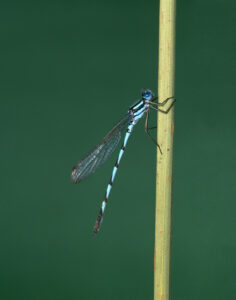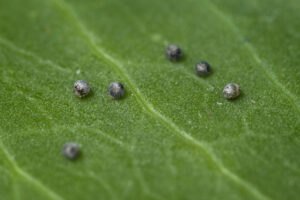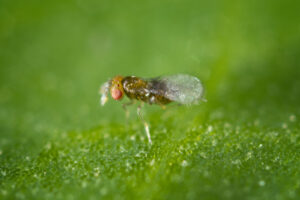
Tiny wasps are the best pest control
By Denis Crawford
Tiny wasps that are barely visible to the naked eye are important biological control agents for various pests. If the wasps are so small, how do you know they are present?
I recently did some photography for a Queensland integrated pest management company that needed photos of Trichogramma pretiosum, a tiny wasp less than a millimetre long. This sort of photography is not everyone’s cup of tea, but I find it a rewarding challenge (if I can get the little devils to sit still).

(Supplied by Denis Crawford of Graphic Science)
Photographs of such tiny wasps are very useful in revealing what the wasps looks like – as they are usually difficult to see with the naked eye. As you can see from the image published here, they are rather attractive insects. They are also important beneficial insects that help control major caterpillar pests such as heliothis (Helicoverpa armigera and H. punctigera), loopers (Chrysodeixis spp.), and cabbage moth aka diamondback moth (Plutella xylostella).
If you want the help of a beneficial insect, it’s best when that insect controls your target pest before the pest causes any damage. That is exactly what Trichogramma pretiosum does, it kills the pest at the egg stage, before any plant damaging caterpillars hatch. Trichogramma pretiosum is an ‘egg parasitoid’ which means an adult female wasp lays her eggs into moth eggs. When the wasp eggs hatch, the larvae feed on the developing caterpillar inside the moth egg, eventually killing it. The moth egg turns black as the wasp larva develops inside. The wasp larva pupates and emerges into a fully formed wasp inside the moth egg. Wasps escape the moth egg by chewing an emergence hole, they then find a mate, and females look for moth eggs to parasitise. A female Trichogramma wasp can parasitise more than fifty moth eggs during her lifespan of up to two weeks.

(Supplied by Denis Crawford of Graphic Science)
Trichogramma pretiosum is a member of the wasp family Trichogrammatidae and there are currently about 800 described species worldwide, with about 140 species described for Australia. Several species in the genus Trichogramma have been mass reared for release as biological control agents against various lepidopteran (moth and butterfly) pests around the world. In fact, they are among the most important biological agents known to science. Trichogramma pretiosum (mentioned above), Trichogramma carverae (egg parasitoid of lightbrown apple moth and codling moth), and Trichogrammatoidea cryptophlebiae (egg parasitoid of macadamia nut borer) are all mass reared in Australia.
Some members of the wasp family Trichogrammatidae are known to parasitise the eggs of aquatic insects. Some of these tiny wasps are capable of either swimming or entering the water by crawling down plant stems or other objects. An Australian species Prestwichia zygopterorum swims underwater to lay its eggs inside the eggs of damselflies. The mind boggles how a tiny insect can break through the surface tension of water and fly/swim down far enough to reach damselfly eggs stuck to an aquatic plant.
A scientific paper from Taiwan about 10 years ago revealed that some wasps use an intriguing method to find damselfly eggs underwater, they hitch a ride on the female damselfly. They have photographic images of female wasps clustered around the base of a damselfly’s abdomen, waiting for her to descend into the water to lay eggs. This hitchhiking behaviour is known as phoresy. I wondered if phoresy had been seen in commercially available Trichogramma wasps and sure enough, one paper (Fatouros and Huigens, 2012) revealed that it had been observed. A European species, Trichogramma brassicae, was recorded riding on female cabbage white butterflies (Pieris rapae). The wasp is commercially available in Europe as a biological control for cabbage white butterfly. Unfortunately, Trichogramma brassicae doesn’t occur in Australia.

Egg parasitoid wasps are so tiny, and their ecological niche is so narrow, that you might think they have evolved relatively recently. Not so. Fossil specimens of Trichogrammatidae have been found in Baltic amber dating back about 45 million years. They might be tiny, but they are not as delicate as they look, and as revealed above they exhibit considerable determination in finding suitable hosts for their eggs.
If you are interested in learning more about the commercially available species, the best place to start is the website goodbugs.org.au which details the species available, and the companies which mass rear them.
My personal experience with Trichogramma wasps began back in the early 1990’s when I was helping commercial field tomato growers learn what to look for in the field. It’s quite simple really. You learn what the host eggs look like, and where to find them, and take a sample of them. In this case it was eggs of Helicoverpa spp. laid on tomato leaves. The leaves were kept somewhere warm for a few days, usually in the farmers ute, until the eggs turned black with parasitism, or didn’t. It’s as easy as that to determine whether parasitic wasps are active in a crop.
Main image: Damselfly eggs are not safe underwater (Supplied by Denis Crawford of Graphic Science)
Reference:
Fatouros NE, Huigens, ME. 2012. Phoresy in the field: natural occurrence of Trichogramma egg parasitoids on butterflies and moths. BioControl 57:493–502
